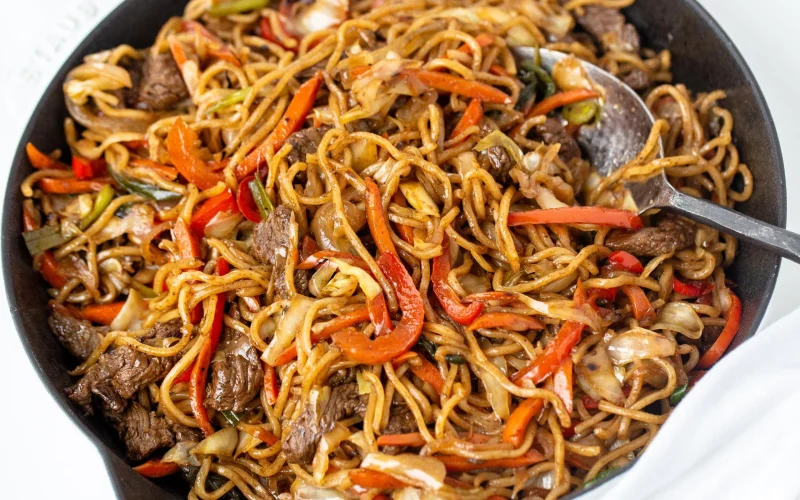One of Japan’s most well-liked street snacks is yakisoba, the equivalent of stir-fried noodles.
The ingredients for yakisoba include a variety of veggies, sliced pork, and a unique sauce.
This sweet and mildly spicy distinctive sauce sets Yakisoba apart from other Asian stir-fried noodles.
Everywhere festivals are held, yakisoba stands can be found. On a big iron plate, many noodles are cooked at the stalls.
Your meal is heated up and taken straight from the iron plate when you purchase.
Making yakisoba, the popular Japanese street food, at home can be intimidating if you’ve never cooked it.
However, this article breaks down the ingredients for yakisoba and provides easy-to-follow steps. Thus, you can quickly prepare a delicious meal!
1. Yellow Noodles
The yellow color of noodles comes from a food coloring called Curcumin. It is an extract from turmeric, a plant related to ginger.
Curcumin also gives yellow to other foods like mustard, butter, and cheese.
Some scientists believe that curcumin has some health benefits, such as reducing inflammation or preventing heart disease.
However, there have not yet been enough studies on humans to confirm these claims.
Therefore, you should discuss with your doctor before using curcumin medicinally in any way since it can have side effects at high doses (source).
We hope you enjoy the first ingredient on our list for yakisoba! Please let us know how it goes, and share your favorite ingredients with us so we can include them in future recipes!
2. Thinly Sliced Pork
Thinly sliced pork, the second ingredient in yakisoba, is often used in Asian stir-fry recipes.
Thinly slicing gives each piece of meat tenderness and flavor and ensures that everything will cook evenly.
In addition, if you’re using pork chops, slice them as thin as possible with a sharp knife. If you have trouble, consider using thinly sliced ham from your supermarket’s deli section.
3. Thinly Sliced Carrot
Carrot is an edible root vegetable. It is usually orange, though purple, black, red, white, and yellow varieties exist.
Carrots are a domesticated form of wild carrot, most likely native to Persia and Central Asia. They have been cultivated since at least 700 BC.
There are also many heirloom varieties of carrots. Carrots are often used in jams, desserts, and baked goods. They are also great ingredients for yakisoba.
Carrots should be stored in a light-colored container in indirect sunlight. They easily absorb ethylene gas, which makes them taste bitter when they mature.
4. Cabbage (cut into bite-size pieces)
In Asia, cabbage is commonly used in soups, stir-fries, and even sushi rolls.
In Japan, cabbage is usually prepared by boiling it with a dash of salt until tender.
It can also be added to soups and salads to enhance flavor.
Plus, cabbage adds crunchiness and nutrition to yakisoba, which is one of the important ingredients.
Cooked cabbage is often served as a side dish alone or with other dishes like tempura or curry rice.
It’s delicious for a warming winter treat when seasoned with shichimi pepper flakes and dipped in hot broth or dashi stock. Some people also enjoy cooked cabbage wrapped in nori for extra texture!
5. Shiitake Mushrooms (thinly sliced)
Shiitake mushrooms are a type of Japanese mushroom native to Japan.
They have been eaten since ancient times and remain a staple ingredient for yakisoba, Japanese cuisine today.
In Japan, shiitake is commonly eaten sauteed with a little soy sauce, sake, or mirin and served as part of a rice dish.
Shiitake mushrooms make great toppings for pizza or pasta sauces! If you can’t find them locally, you can order them online.
You can substitute any other kind of mushroom if you prefer, but make sure it’s fresh! If you do use dried shiitakes, try rehydrating them before using them.
6. Bean Sprouts
Although you can use any bean sprouts for yakisoba, mung bean sprouts are usually used.
They make a good base ingredient to mix with other ingredients for yakisoba because they have a crisp texture. Plus, they don’t go soggy when cooked.
You can also find them in most Asian or larger supermarkets, sometimes next to regular bean sprouts. Make sure you wash off any dirt that may still be on them before using them in your yakisoba.
7. Green Onion (sliced diagonally)
Although most recipes omit green onion from the list of ingredients for yakisoba, I believe including it is crucial to nailing a great bowl of noodles.
The onion adds essential depth and dimension to your yakisoba, so don’t skip it.
If you don’t have green onions on hand, you can add chopped regular onions instead. Just remember to include them in your ingredient list!
8. Oil To Stir-fry Ingredients
Oil is somehow inevitable when discussing the ingredients for yakisoba.
However, you’ll want to use a neutral-tasting oil so your yakisoba doesn’t taste too greasy.
Some recipes call for peanut oil or vegetable oil. But, we prefer canola oil in our stir-fry recipes because of its clean, neutral taste and high smoke point (410 degrees F).
Also, it’s fairly inexpensive, which is always nice. It’s an underrated oil that you should add to your pantry.
Meanwhile, you’ll only need a couple of tablespoons of canola to make yakisoba.
Be sure to measure with a measuring spoon and not by eye (or else you could easily overuse it!).
9. Sesame Oil to Mix Into the Noodles
Last but not least, the ingredient for yakisoba is Sesame Oil. Although its aromatic smell and rich taste are wonderful, avoid using it as a cooking oil because its smoke point is lower than other oils.
Sesame oil’s high-temperature tolerance makes it best suited for use as a seasoning or mixed with other oils and used at low temperatures while pan-frying meat or vegetables.
If you want to add flavor without adding fat and calories, mix a few drops of sesame oil into your yakisoba sauce.
Using any sesame oil will yield different results depending on how strong you prefer your noodles’ taste. Mix according to your own preference.








